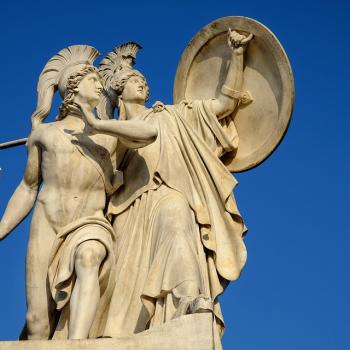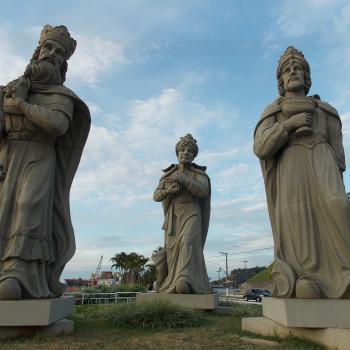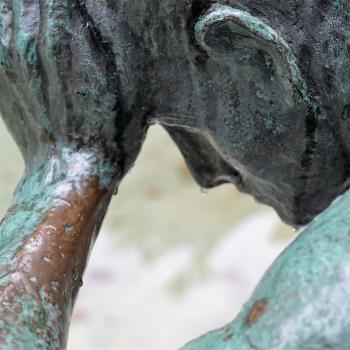We’re exploring the idea of a Christian spirituality that is more thoroughly grounded in the Trinity, a teaching that is difficult, sometimes cryptic, and all too often inconsequential in actual Christian life and practice. We’re using Khaled Anatolios’ book (Retrieving Nicaea) as our guide, but his book is not primarily a theological study of Trinitarian doctrine.
This is a good place to pick up on the pearly gates image from our last post. My concern (not necessarily Anatolios’) is that we hold onto the doctrine of the Trinity in order to be “theological correct” rather than because it has any meaning or generates any passion for us. But the reason this conversation can really only take place after Easter is because this is, as I’ve mentioned, the time in the early church when the newly baptized would be taught the mysteries of the faith. They called these kinds of teachings mystagogy. They came after baptism because these are things that can only be approached on the near side of faith, as it were.
The thief on the cross, the teenager in a Young Life club, the inquirer or seeker, the curious and clever—none of these need to wrestle with the doctrine of the Trinity in order to come into relationship with God in Christ. They need to see Jesus. Jesus didn’t sit with Nicodemus and say, “Well, hey, there’s one more thing. If you want real life, you need to get this part…”
But the church found that, once we saw Jesus—really saw him, fell at his feet and worshipped him as immeasurably worthy—then the mysteries began to roll over one another, deeper and deeper; the simple step of faith became an adventure that Mr. Tumnus, in C.S. Lewis’ The Last Battle, described as “an onion: except that as you continue to go in and in, each circle is larger than the last.” The constant call and invitation in that magical place? “Don’t stop! Further up and further in!”
One friend, commenting on some of these posts, said, “Trying to understand the Trinity is like a physicist getting too close to an Event Horizon: it will suck you in.” Exactly!!
As long as we want to study the whole thing objectively, dissect its parts, and manipulate the data, we had darn well better stay at a safe distance. But Anatolios’ book is an exploration into the ways that the early church fathers so encountered this great mystery, the greatest of all Event Horizons, that they understood in some measure that “getting sucked in” is the whole point. God’s inner dynamic, his Three-in-Oneness, is an invitation into the mysteries of relationship with God, a relationship that moves past Martin Buber’s “I-Thou” encounter into Jesus’ wonderful dynamic of “I in the Father and you in me and I in you.”
So, we’re taking a historical approach to Trinitarian doctrine rather than a purely theological one. Obviously, we’re wading into deep theology, but Anatolios’ big argument is that we can only understand the ways the theological language worked itself out if we look at the ways that the early church fathers wrote and believed. They hammered out our Trinitarian formula in the essential creeds of the Church, but what, really, were they passionate about? What did they see? Where did the language come from? What did the words mean to them?
Maybe we should stop here and just talk for a minute about the Nicene Creed, the key Christian summary of Trinitarian doctrine. Some of you say it every Sunday in Church; others last saw it in a textbook in seminary; maybe some of you have never looked at it carefully. Here it is, in its final form as recited in the West:
We believe in one God,
the Father, the Almighty,
maker of heaven and earth,
of all that is, seen and unseen.
We believe in one Lord, Jesus Christ,
the only Son of God,
eternally begotten of the Father,
God from God, Light from Light,
true God from true God,
begotten, not made,
of one Being with the Father.
Through him all things were made.
For us and for our salvation
he came down from heaven:
by the power of the Holy Spirit
he became incarnate from the Virgin Mary,
and was made man.
For our sake he was crucified under Pontius Pilate;
he suffered death and was buried.
On the third day he rose again
in accordance with the Scriptures;
he ascended into heaven
and is seated at the right hand of the Father.
He will come again in glory to judge the living and the dead,
and his kingdom will have no end.
We believe in the Holy Spirit, the Lord, the giver of life,
who proceeds from the Father and the Son.
With the Father and the Son he is worshiped and glorified.
He has spoken through the Prophets.
We believe in one holy catholic and apostolic Church.
We acknowledge one baptism for the forgiveness of sins.
We look for the resurrection of the dead,
and the life of the world to come. Amen.
This Creed was the culmination of a large council of bishops who gathered together in Nicaea, which is a smallish town outside of Constantinople (today Istanbul), in A.D. 325. The council was provoked by a pastor in Egypt who had begun to introduce some new ideas (which were later deemed heretical) about the Trinity. Many believed these teachings were not true, but just as many or more believed they were true. (We’ll get to some of those teachings in future posts.) The Nicene Creed was supposed to close the door to those false teachings. It didn’t do a very good job, because the controversy went on and on; the Creed was actually revised by another council in 381, and the Creed we use (above) is that later council’s version (with one key exception, which we will address later too).
But stop for a few minutes and go back and reread the Creed. Just look at what it says about the nature of God. Note some of the ways that it can dispel Modern Approaches 1, 2, and 3. Linger over the images of the Father, the Son, and the Spirit; ponder our place in the Creed.
This piece of literature is magnificent, powerful, and beautiful. Not perfect, not an explanation, and not meant to be the end of all discussion. It is, instead, merely the fence around that great green meadow within which we explore Trinitarian ideas.
So Anatolios tells us that the best way to understand this Creed and the language it uses is not to put it out there as a document you must sign to “get in,” but to understand how it emerged from a larger conversation about what Christians were already believing and practicing. (Utter nonsense that the Council of Nicea conspired to make the human prophet Jesus into a divine character in order to accomplish a political agenda, no matter what Dan Brown says.) Anatolios puts it this way: “Orthodox trinitarian doctrine emerged as a kind of meta-doctrine that involved a global interpretation of Christian life and faith and indeed evoked a global interpretation of reality.”
In K.M. language, this might say: The Creed, and its powerful language, was the summation of a much, much larger vision of what it means to be a Christian and that vision says something true about all reality, all that is.
The early church fathers weren’t just trying to get their theological ‘ps and qs’ in order so that they could figure out who was in and who was out, or who was a heretic and who was authentic. Their Trinitarian arm-wrestling (and actually, it got a lot more violent than that at times—our occasional raucous political conventions have nothing on some of those councils!) was a debate about the “entirety of Christian existence.”
The Last Battle describes this time of mystagogy, of us moving into the great mysteries of God, as a life that “goes on forever [and] every chapter is better than the one before.”
So, we’re going into the heart of theology by taking the history path (which you know is where I was going to take you all along). And Anatolios tells us that there are two important principles we absolutely must keep in mind. And that’s what we’ll explore next.
___________________________
Note to Reader: This series on Trinitarian Spirituality explores the history and spirituality behind the shaping of the Nicene Creed using Khaled Anatolios’ Retrieving Nicaea: The Development and Meaning of Trinitarian Doctrine (Grand Rapids, MI: Baker Academic, 2011) as guide and inspiration. It’s best to begin at the beginning: An Introduction.












